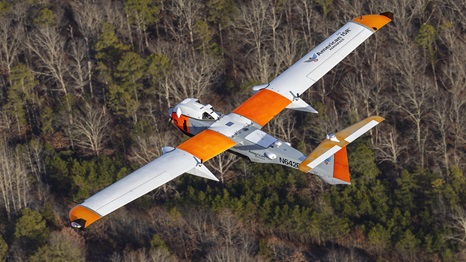our operations
methane detection by airplane is taking off
2 min read | october 10, 2023
Vanessa Ryan (right), Chevron’s manager of methane reduction, and Bruce Niemeyer (second from left), president of Americas Exploration and Production, recently traveled to Bozeman, Montana, to meet with Bridger Photonics executives and investors.
Airplanes are used to deliver cargo, shuttle travelers, fight fires—and even mitigate methane emissions.
Chevron is teaming up with Bridger Photonics, using their flyovers to detect methane leaks along pipelines and other infrastructure. The information shared can be used to guide repairs.
Chevron's work is expanding to cover operations in the Permian Basin, the DJ Basin and more recently, San Joaquin Valley, California.
“Our goal is simple—keep methane in the pipe. This technology helps us assure we are doing that,” said Bruce Niemeyer, Chevron’s Americas president of Exploration and Production. “It’s a gamechanger. It can find leaks that are 10 times smaller than other commercial providers are capable of spotting.”
how it works
Ground mapping boxes are affixed to Bridger Photonics’ aircraft wings to capture data from the areas below. Its sensor sends a continuous laser beam and measures the reflected light. The data is collected and shared.
high flying
“Our performance and continuous improvement in methane reduction space is thanks to collaborations like this,” Niemeyer said. “Bridger’s technology is helping us continue to deliver lower carbon results.”
The promise of Bridger Photonics technology has caught the attention of industry leaders. In fact, Jamie Dimon, CEO of JP Morgan Chase & Co., joined Niemeyer and Vanessa Ryan, Chevron’s manager of methane reduction, along with other energy leaders during a meeting in Bozeman, Montana, in August

Aircraft-based solutions like Bridger Photonics (pictured) help Chevron and nearby operators cost-effectively screen assets for methane emissions across a wide geographic footprint.
why it matters
Methane is the second-most common greenhouse gas released by human activity. Chevron, along with other oil and gas companies, are working with Bridger Photonics to help keep methane where it belongs: in the pipe.

Bridger Photonics’ aerial radar technology detected the methane leak, pictured above, at a Permian Basin facility in June 2021. An October 2021 follow-up flyover detected no emissions after facility repairs were made. (Color added for effect.)
in plane sight
Methane emissions are odorless and colorless, making them impossible to spot with the naked eye.
Chevron uses a range of technologies to detect methane such as drones, handheld devices and satellites. Sensor-equipped airplanes can:
- Cover hundreds of sites per day, compared to onshore drones capable of covering just tens of sites per day.
- Provide timely data; results are often available within days, while it can take months for other technologies to deliver data.
- Identify sizable emissions above a certain threshold immediately, and alert companies so they can be addressed right away.
“Because it’s from the air and not something that you have to focus a lens at, it sees the whole site and can cover a wider range of leaks,” Ryan said. “It makes it possible to spot things like underground pipeline leaks that other technologies might not detect.”
vanessa ryan
manager of methane reduction
topics covered
related content
chevron email updates
Subscribe to our newsletter to receive news and updates.







